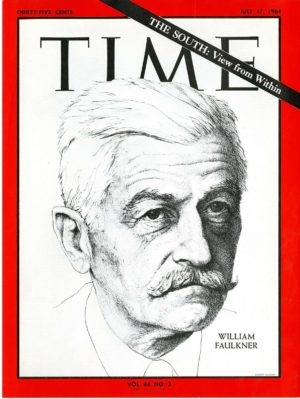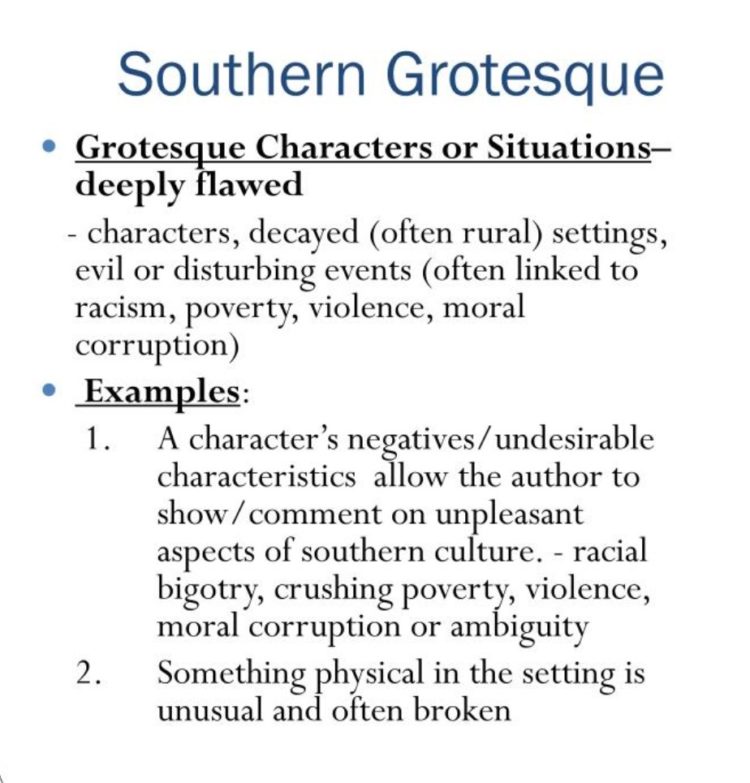“Southern” Grotesque

by Andrew Hamilton
IS post-WWII Southern Gothic literature systemically anti-White?
I first touched upon this overlooked question in “Curb Your Enthusiasm,” prompted by a startling critique of Flannery O’Connor’s work by Vietnamese writer Linh Dinh. (“Flannery O’Connor’s White Trash,” April 19, 2021.)
He noted that “the term ‘white trash’ has been compacted to just ‘whites,’ it’s not just about the South.” This has been true from the beginning.
A National Vanguard reader persuasively suggested that Georgia author Carson McCullers’ work falls into the same category.
Checking her background revealed a familiar pattern: “Like [Flannery] O’Connor, the stories and novels of Carson McCullers (born Lula Carson Smith, 1917–1967) are steeped in the grotesque. An abundance of [White] ‘freaks’ fill the pages: dwarfs, giants, cross-dressers, homosexuals, and deaf-mutes.” (Oxford Research Encyclopedia of Literature, Oxford University Press, 2021.)
Playwright Tennessee Williams and Greek American director Elia Kazan’s 1956 motion picture Baby Doll, a flagrantly anti-Southern film, had previously made a strong negative impression on me. Williams (a homosexual) is routinely classified as a central Southern Gothic writer.
Williams and McCullers (a lesbian) were personal friends and admired each other’s work.
The evidence suggests that the most highly-acclaimed creators of this literature served the interests of the post-war American elite while deviously undermining their own region.
Wilmot Robertson noted the propensity of Whites to collaborate with Jews and other anti-White elements against their own people:
Is it not incredible that the largest American population group, the group with the deepest roots, the most orderly and most technically proficient group, the nuclear population group of American culture and of the American gene pool, should have lost its preeminence to weaker, less established, less numerous, culturally heterogeneous, and often mutually hostile minorities?
With all due allowance for minority dynamism and for the variety of causes reviewed in earlier chapters, this miraculous shift of power could never have taken place without a Majority “split in the ranks” — without the active assistance and participation of Majority members themselves. (The Dispossessed Majority, 3rd ed., 1981, p. 99.)
This process can be observed in microcosm in Southern Gothic literature. America’s culture creators/distorters wanted it to be produced primarily by White Southerners. Despite an occasional exception, they consciously sought out talent with this in mind.
One exception was a popular movie created by a Hollywood trio consisting of Yankee director Robert Aldrich, a philo-Semitic, pro-Communist scion of the Aldrich family of Rhode Island, California-born writer Henry Farrell, and Jewish scriptwriter Lukas Heller. Their first collaboration, Whatever Happened to Baby Jane? (1962), set in Hollywood, was American Gothic, but its follow-up, Hush . . . Hush, Sweet Charlotte (1964), was a characteristic Southern Gothic tale set in Louisiana.
But Jews and their mid-century Gentile collaborators recruited primarily indigenous Southerners to create such material. They wanted racial defamation to appear to emanate from within rather than from without. Read the banner accompanying the portrait of William Faulkner on the 1964 cover of Time magazine (photo below): “The South: View from Within.”
Defamation and Denigration
“Southern Gothic,” also labeled “Southern Grotesque” by anti-American academics and critics, was inaugurated by Faulkner in the late 1920s. It placed heavy emphasis on repulsive White racists, criminals, freaks, grotesques, weirdos, and the mentally ill. The label is a sly euphemism disguising more than a little anti-White animus against the South, and through it White Americans as a whole.
What did Jews and the hardcore Gentile Left — then as now the gatekeepers, creators, and censors of American culture — seek from the Southern authors they hyped?
First and foremost they expected backstabbing betrayal: defamation and denigration of Southerners as a group. This effectively instilled revulsion in outsiders, and hatred of self-kind among “decent” Southerners. The characters and environments in the stories were typically alien, corrupt, dangerous. The entire atmosphere exuded The Other.
At an individual, subconscious level it works like this: “I’m not Southern. This is all very strange, alien, and repulsive to me.” Among Southerners: “I’m not like that. I’m Atticus Finch.” Both groups implicitly accepted a surreal distortion of reality as truth because they had no independent, opposing, free sources of information to challenge what was placed before them and ceaselessly repeated as fact.
New Orleans-born Truman Capote, notable for his exaggeratedly effeminate voice and mannerisms, “is often placed in the school of Southern Gothic writers. Other Voices, Other Rooms (1948) relies on obvious elements of Southern Gothic, from its secluded, decaying mansion at Skull’s Landing to scenes of pedophilia and violence, as well as . . . a crossdresser, a mute quadriplegic, and a dwarf.” (Oxford Research Encyclopedia of Literature.)
Capote’s birth name was Truman Streckfus Persons. “Capote” is the surname he received when his mother’s second husband, Cuban José García Capote, a New York City bookkeeper and embezzler, adopted the boy and renamed him Truman Garcia Capote.
Commonly, White “racism” features in these stories.
A well-known archetype forced down the gullets of generations of White schoolchildren is Harper Lee’s To Kill a Mockingbird (1960), identified by one major authority as “perhaps the most widely read and most-loved Southern Gothic [novel] of the 20th century.” It was awarded a Pulitzer Prize and turned into a blockbuster Hollywood motion picture starring Gregory Peck that won three Academy Awards and “received widespread critical acclaim.”
Today, Left-wing elites sneer at and even ban the book. Jewish media monopolist Brian Roberts’ NBC paid an academic house Negress to lecture us: “The book cannot continue to be taught as if every person in the classroom is white, upper middle class and needs to be prodded into being Scout.”
So that was its purpose. (Note the target: the White upper middle class.) It wasn’t really about the novel’s unsurpassed literary merit. Since the initial objective has been achieved, it’s time to move on to rawer, more explicit forms of racism.
That’s the point: genocide (an international crime) is an ongoing dynamic.
Capote and Harper Lee were friends from childhood, and Lee helped Capote write his most famous book, In Cold Blood (1966). Each one used the other as a fictional character in one of their books.
On a popular level, John Grisham has been remunerated with fabulous wealth and popularity for his many renegade novels vilifying Whites. Often characterized as legal thrillers set in the South, his novels are also seen as part of the Southern Gothic tradition.
“A disproportionate number of all modern Majority literary lights are Southerners”
Post-WWII mainstream Southern literature has been promoted by certain “conservatives” and “neo-Confederates” as a positive expression of regional values.
The fact that such people laud many of the same literary figures lionized by the Left is beside the point. These supposed traditionalists are philo-Semites and “minority” worshippers. They do not conserve anything, least of all their own people, genes, traditions, or even symbols and monuments. They continuously surrender, valorize “minorities,” and attack Whites whose principles they correctly fear Jews will dishonestly rub onto them to their detriment.
But even men made of sterner stuff have extolled post-War Southern writers because of their regional roots without sufficiently examining their backgrounds or the disturbing content of their work. They fail to adequately consider the overwhelmingly hostile institutional and cultural framework that initiated, developed, and shaped the genre.
Wilmot Robertson is a good example to use because he is a strong rather than weak advocate. He was no phony conservative content to surrender surrender surrender. He believed in our cause, not the enemy’s.
Robertson argued for the social significance of mid-century Southern writers from a racialist perspective. In “The Dissolution of Art” in The Dispossessed Majority he contended:
The power and sustenance that an artist derives from being part of a racially and culturally homogeneous community helps explain the success of William Faulkner, the one first-rate Majority writer who survived both as an individual and as an artist the nationwide uprooting of his cultural heritage. Faulkner was born, lived, flourished, and is buried in Mississippi, adjudged to be the fourth most illiterate state [according to a 1960 Census Bureau estimate]. Because they totally ignore the communal nature of art, liberals and Marxists can only treat Faulkner as a paradox. Environmentalist logic cannot explain why a supposedly backward state in the Deep South should produce America’s greatest twentieth-century novelist. (The Dispossessed Majority, 3rd ed., 1981, p. 248)
He added in a footnote:
Just as they treat as a paradox the fact that a disproportionate number of all modern Majority literary lights are Southerners: James Agee, Flannery O’Connor, Katherine Anne Porter, John Crowe Ransom, Robert Penn Warren, Thomas Wolfe, Walker Percy, James Dickey, Stark Young, Carson McCullers, Eudora Welty, Allen Tate, Tom Wolfe, to name a few.
Let’s analyze this. To anticipate: Robertson’s error was to embrace “literary lights” — by definition writers selected and groomed, or at least accepted, by a deeply hostile elite. It is understandable why he thought this bolstered his case, but it undermined it.
It is doubtful that Robertson read most of the writers mentioned, including Faulkner. This is unsurprising given his workload and focus. Indeed, it is probably true of White racialists who instinctively agree with him as well, and of most milquetoast “conservatives” and “neo-Confederates,” though in the latter case it doesn’t matter because they are in step with the Left anyway.
To test this hypothesis I looked up every occurrence of Faulkner’s name in Instauration magazine’s two-decade archive and found not a single major or minor article about the man. (Instauration was the monthly underground magazine Robertson founded and edited from 1977 to 2000.)
That is a major oversight for someone as racially attuned as Robertson said Faulkner was.
Faulkner was fêted by elite academia and New York’s literary-publishing-media clique. A 1967 article in Modern Fiction Studies speculated that “Faulkner probably received more critical attention during the past decade [1957-1967] than any other American novelist.” He was twice featured on the cover of Time magazine, first in 1939 and again in 1964 as part of that magazine’s celebration of the implementation of the newly-passed Civil Rights Act.

In the accompanying cover story extolling Faulkner’s oeuvre in the same issue, the magazine characterized it as follows:
For him the crime of the South was chattel slavery, and the white man’s denial of the Negro’s equal humanity was an ineradicable curse on the land and its people. Ever since, Faulkner argues, the white Southerner has been burdened by a crippling, unacknowledged guilt, as intimate and inescapable as if taken in with the milk of his mother — or of his Negro wet nurse.
The defeated whites clung to the past. They were scared because they felt that they were few and the Negroes myriad; they were stubborn because only by convincing themselves that the Negro was somehow inferior, like a pet or a horse, could they justify their long crime of refusing to recognize him as an equal human being; they were violent.
He teaches again and again the fear and the reality of miscegenation, and he makes comprehensive the sexual hysteria behind the myth of Southern white womanhood.
Flem Snopes and his rootless clan are a Faulkner creation that rose up and walked off the page. Throughout the South today [emphasis added], “Snopes” is a derisive epithet for men ranging from leading demagogic politicians down to the Klansman next door. –“Books: The Curse & The Hope,”July 17, 1964.
Note they said “Snopes” was a common epithet for White racialists used by “respectable” Southerners themselves.
We see where this has led. As movie critic Richard Schickel said of Clint Eastwood: “No one gets the kind of acclaim that has accrued to Clint over the last decade and a half [1980-1995] without institutional support.”
The problem is that Faulkner’s institutional support, which was massive, was hyper-attuned to race race race race. That can’t possibly have been good for us.
Beyond Faulkner
Turning to other names on Robertson’s list, elsewhere in the same book he referred to James Agee as a “Truckler of some talent who preferred Chinese and Negroes to his own people, despised Irishmen and Germans, and married a Jewess.” Agee had a child with her. After their divorce she remarried and moved to East Germany in 1948, where she and her new husband became part of the Communist intelligentsia. In 1981 Agee’s half-Jewish son published a memoir, Twelve Years: An American Boyhood in East Germany.
A convert to Catholicism, Walker Percy condemned Southern segregation from a Christian point of view in the Catholic magazine Commonweal as early as 1956. His first, best-known novel was heavily shaped by his Jewish New York City editor, and published by the Jewish firm Alfred A. Knopf.
Instauration called Robert Penn Warren “the chief literary scalawag of the 20th century.” He was a Negro-booster and proponent of Black-White integration. His best-known novel, All the King’s Men (1946), an attack on Huey Long, was awarded the Pulitzer Prize. The Hollywood adaptation won the Best Picture Oscar. As a consequence, Warren made lots of money and garnered nationwide critical acclaim.
Katherine Anne Porter in her later years (she lived to be 90) wandered off the PC reservation a bit, at least in her private opinions; three acerbic comments by her were quoted approvingly in the magazine, though her literary work was not examined. Throughout her career she was economically supported by positions at universities.
Novelist Thomas Wolfe was the author most frequently cited by Instauration’s writers — negatively by only one.
New Journalist and novelist Tom Wolfe was certainly the outstanding talent on Robertson’s list. His novels A Man in Full (1998), I Am Charlotte Simmons (2004), and Back to Blood (2012) all feature Southern characters or locales to some extent, as does some of his outstanding journalism, including a 1965 essay on North Carolina NASCAR driver Junior Johnson and his famous portrayal of legendary test pilot Chuck Yeager in The Right Stuff (1979). None of his work exhibits the negative qualities of the others’.

Among the writers listed by Robertson (apart from Tom Wolfe), perhaps the highest odds of discovering value would be in the works of Allen Tate, and possibly Katherine Anne Porter and Thomas Wolfe.
Phantasmagoria
Not mentioned by Robertson in his book, despite being highly celebrated by American society, Instauration dubbed Tennessee Williams “the fairy godmother of Broadway” and commemorated Erskine Caldwell’s death with the headline “Death of a Scalawag.”
In truth, most postwar Southern writers seem to closely fit Robertson’s description of racial outsiders in the same chapter:
The fatal flaw that denies the minority artist a place among the artistic great is his inherent alienation. Because he does not really belong, because he is writing or painting or composing for “other people,” he pushes a little too hard, raises his voice a little too high, makes his point a little too desperately. He is, inevitably, in the land, but not of the land. His art seems always encumbered by an artificial dimension.
Consequently,
The minority artist may concentrate on proving his “non-belonging.” Instead of adopting the host culture, he now rejects it [several of Robertson’s Southern writers, for example, converted to Catholicism]. . . In the process his art becomes a weapon. . . . All that remains is the crude force of his stridency and his “message.”
Robertson cites several examples, one of which is Rodgers and Hammerstein’s “totally counterfeit” musical Oklahoma! (Richard Rodgers and Oscar Hammerstein were Jews.)
Though I have not seen Tennessee Williams’ play Cat on a Hot Tin Roof, I’ve caught snatches of the movie directed by Jew Richard Brooks (real name Reuben Sax), an anti-White bigot and “perpetually angry man” who once struck 5′ 2″, 24-year-old blonde actress Debbie Reynolds in the face on a movie set and had to be forcibly restrained from continuing his attack.
The characters with their outlandish names (“Big Daddy,” “Big Mama,” “Maggie the Cat,” “Gooper,” “Brick” — like “Rock,” awkward under the circumstances) and dialogue (Big Daddy: “Uh-huh, this girl has life in her body, that’s no lie!” [actually, Maggie had lied to him about being pregnant]) sounded embarrassingly ersatz.
Let’s face it. Williams knew a lot more about the denizens of New York City, Key West, and Provincetown than he did about Southerners. Though born in Columbus, Mississippi, his family moved to St. Louis, Missouri when he was 8. He could never have become — or remained — rich and famous if he’d written scornfully about those people. Assuredly, he’d have been crucified.
A case in point is Truman Capote. The withdrawal of social approval by wealthy Jewish media monopolist William Paley (CBS) after the publication of “La Côte Basque, 1965” (Esquire, November 1975) was the beginning of the end for that writer, personally and professionally.
Paley and his glamorous White wife Babe had for years coddled the 5′ 3″ homosexual like a pet poodle. But suddenly Capote’s clique of powerful patrons cast him aside and his world came crashing down.

Poor Whites did not have that kind of power. Therefore they were easy targets, fun to caricature for the condescending amusement of New Yorkers and their media and academic retinues. Lampooning and running a lance through fictitious, monstrous Southerners — the more bizarre the better — lined your pockets and won fawning praise rather than a terrifying social death.
“Southern” Grotesque fiction was written primarily by Whites, some of whom remained in the South their entire lives, others who left never to return. Their work isn’t truly of the South. It is against the South, contemptuous of the South — a phantasmagoric collective hallucination concealing a sinister agenda.
At bottom it is intolerant of all Whites.
How do the Jews identify, cultivate, enlist, and enthrone such Judas goats — in this case, writers, critics, and academics — and thereby lead an entire population to its doom? That is a conundrum that must be solved, and a deadly partnership that must be liquidated from both sides.
“This miraculous shift of power could never have taken place without a Majority ‘split in the ranks’—without the active assistance and participation of Majority members themselves.”
* * *
Source: Author







Interesting. I really like Flannery O’Connor and Carson McCullers. My take on their work was that it was the product of a conquered people. It’s my impression that the South suffered psychologically for decades and maybe still do, after the Civil War.
I believe wars have multipole objectives and that only one of the objectives of the Civil War, was to take down a planter aristocracy that was emerging in the south. At the start of the war, the American south, “Dixie” had 70% market share of the world cotton supply.
I am reminded of the 1950s era Asch Conformity experiment where it was shown that peer pressure is so enveloping, that test subjects chose answers they knew to be wrong in order to conform. After reading this article, I can see that we are all in the Asch experiment conforming to the hype put out by Time magazine and all media telling us what is good art and abandoning any pretense to judgement, we readily agree because we want to be part of the “In Crowd.” Well guess what? The new “In” thing is to get vaxxed. I saw one video where a vaxxed victim was rolled out on a gurney, apparently unconscious, and not one in line to get vaxxed thought anything of it – they wanted theirs too!
Once you’re conscious, White behavior in the presence of Jews, and especially within authoritarian/totalitarian Jewish societies, becomes nearly 100% predictable. But why Whites do what they do is perplexing. At this stage, I consider it a black box: given an input, you know what the output (verbal or behavioral) will be ahead of time. But what happens inside their heads remains a mystery. (Though Orwell supplies many answers.) My working hypothesis is that Whites (all Gentiles, really) will a) conform and b) obey. I base this on Asch’s conformity experiments, and his student Stanley Milgram’s more famous obedience to authority experiments. (Plus, of course, just common observation!) For readers who don’t know, Asch and Milgram were Jewish experimental psychologists. (They experimented on human beings.) Milgram was Asch’s student. Milgram conducted… Read more »
I believe much can be explained by Unitarian thought, just play nice in the sandbox and forget all ideology. The American psyche was brought up from the beginning, 1776, on the mantra that monarchy and aristocracy are bad. It is just the opposite, you cannot have an orderly society without monarchy and aristocracy to tell the people what’s what and what to do. Now, Americans do not only not subscribe to monarchy and aristocracy, they are hostile to it.
Patrick Pappano: I am reminded of the 1950s era Asch Conformity experiment where it was shown that peer pressure is so enveloping, that test subjects chose answers they knew to be wrong in order to conform… — Thanks for that. We don’t need Jew experimental psychologists like Asch or his protégé Milgram to explain the power of conformity among humans. Whether he coined the term lemming, or not, Dr. Pierce has been the foremost promoter of the concept of lemminghood in plain English, and how most folks “run with the herd,” but from a White racial survival point of view. Note this by him from the year 2000. …Lemminghood is not a condition which is defined with absolute sharpness. I have known lemmings who were almost human, lemmings who were… Read more »
I weep for my lost south.
Nice intellectual effort, but I’m not seeing it. The South never developed what became known as Stockholm Syndrome. It was the rise of Southern-fried racism in the 1960s that motivated the Federals to reinvade the Southern county. Our schools and universities were White. The Negroes had their own schools, water fountains and restrooms. The oil companies understood they had no choice but to add a 3d restroom at filling stations. Coloreds around back. Whites only signs everywhere. Silly White Yankee girls came down as Freedom Riders with their Negro boyfriend or husband to ride on the front of the bus. When they realized those mean ol’ Southern boys had no problem setting busses on fire, they left town like a nigger after he stole a hubcap. We literally went on… Read more »
What an interesting piece about Southern writers. I learned a lot from this, thanks. My favorite Southern writer by far is William Pierce. We know what Jews have to say about him and his body of work, fiction and non-fiction. A few others like Atlanta attorney Sam Dickson are enough for me.without getting into Faulkner or Grisham. Your mention of Paley (original Jewish family name Palinsky) and his glamorous White wife Babe intrigued me so I hit the hyperlink to read about his shiksa. I didn’t get far into the Vanity Fair piece, however, before being blocked unless I was willing to pay at lease $8 to see the rest of the article. How Jewish! A slightly-related piece written nearly 40 years ago for National Vanguard magazine by Vic Olvir, transcribed by… Read more »
The Pierce-Robertson meeting is the kind of thing that in a sane world would have been recorded on audio/video media for posterity. Even if it couldn’t be publicly shown for a long time. You were indeed fortunate to witness that. And all these years I thought Robertson lived in Cape Canaveral, Florida, where Instauration was mailed from! Not really, but I did assume he’d retired to the state, perhaps to a nearby town. He must have put forth a lot of effort to utilize the symbolism of that mailing address. I’d read Olvir’s article at least twice in the print magazine, but now I have an electronic copy as well, so thanks for that. I missed it the first time around in 2012. Even so, my mind played tricks on… Read more »
And all these years I thought Robertson lived in Cape Canaveral, Florida, where Instauration was mailed from. — You were not the only person fooled by WR about his true location. Every month all correspondence to him was mailed to Florida, then forwarded to NC, then the finished Instauration was mailed each month to subscribers like clockwork from Florida. Remember, this elaborate underground deception was mostly accomplished during pre-Internet days, and WR never missed his monthly deadline for the 25 years, or so, of his chronicling our cause, as far as I know. Amazing! It was Wilmot’s dedicated wife, however, who managed the magazine so professionally — another well-kept secret. Perhaps it was because I’d worked for WLP and WR then that I considered them, along with Ben Klassen, who I’d also… Read more »
The Pierce-Robertson meeting is the kind of thing that in a sane world would have been recorded on audio/video media for posterity… — It’s too bad we few who are sane must operate in such an insane world gone stark raving mad. I’d asked WR if he would at least pose for a photo with WLP for posterity sake and he declined. What an exciting two-day period that was for me. The day before their back-and-forth Pierce’s wife took a photo of me standing between her husband and BK, all smiling after doing physical work together, with my arms around their shoulders. What a prized photograph: little me, standing between two of the foremost giants of our race who each, more or less independently, had founded new non-Semitic religions for… Read more »
The imperishable spirit of the South. Thomas Dixon’s “The Clansman” evolved from the best selling novel of 1905 into a Broadway hit and by 1915 into the most successful of early movies. “The Birth of a Nation.” I read years ago that the Southern school of novelists led the way through the 1940s and then faded. They were replaced by people with shallow Anglo-Saxon, Celtic roots. The movie styled GLORY was released in 1989. It’s a remarkable fact that the first Review of the film can be considered written in 1863. Charleston Harbor — Assault On Fort Wagner. July 22, 1863. Brigadier General R.S. Ripley, Commanding “The carnage of the enemy in the confined space in front of Battery Wagner was extreme. The ditch and glacis were encumbered… Read more »
What’s being described here is a process of demoralization. Jews are great at it. It’s sort of a form of anti-identity politics: they fabricate a group you don’t want to be associated with, and if you suspect you might belong to this group, you want to get out of it and disassociate from it. This destroys the group, and it doesn’t matter that all its supposed ills were conjured up in Jewish imagination. The point is that people believe it, and their actions follow.
Very true, WN Lady. Demoralization of Whites is the goal in much of Jewish-controlled fiction, even when a more direct anti-White theme is absent. Plots which involve whole families or classes of Whites who act like total scumbags (like Jews, in fact); Whites who betray every principle they claim to believe in; Whites mistreating other Whites with no sense of conscience whatever; dramas in which all the characters — mostly or all Whites — are morally bankrupt, with no hero in sight. The not-so-subtle message is There no hope in sight, no hope ever. This is the way we are. These are the stigmata of nearly all “modern” “sophisticated” drama, as vended to us by Jews. Netflix, for but one example, is full of it. No wonder suicide rates, hopelessness,… Read more »
Jews have lived in the South since colonial times. Many hid their roots out of fear.
Mr. Strom, ‘Demoralization’ is a good word choice. White society suffers from Popular Demoralization across the country. They keep their head down. They go home at night and lock the door.
Anon, your observation on Jews in the South is correct. To this day, their behavior is skittish on the local level. They understand that the folk have a long history of lashing out at any given time for any given reason.
This is a superb essay. I was aware that our literature and culture were distorted by Jews, but I was not aware it was done on such a complete level. It’s devastating when you realize your “high culture” is actually schlock wrapped around a poison center.
For the mountain South of VA, WV, NC, TN etc. that is lumped in as “Southern”, contempt of the White southerner has kept successful, liberal North-easterners from settling or buying up large land areas there, often within a 7 hours drive of home, in politically significant numbers (VA recently is an exception). Although the Carolinas have had a large influx of northern retirees, they haven’t been politically-Left activists or jews. On recent travels in mountainous VA, WV, TN and NC I saw widespread signs of poverty – boarded homes, rundown trailers, old cars used as lawn planters, dead farm equipment, churches outnumbering urgent care, specialist or hospital annexes by 100:1 in a given area, streams choked by algae from fertilizer run-off from poorly managed farms, a backdrop of opioid abuse… Read more »